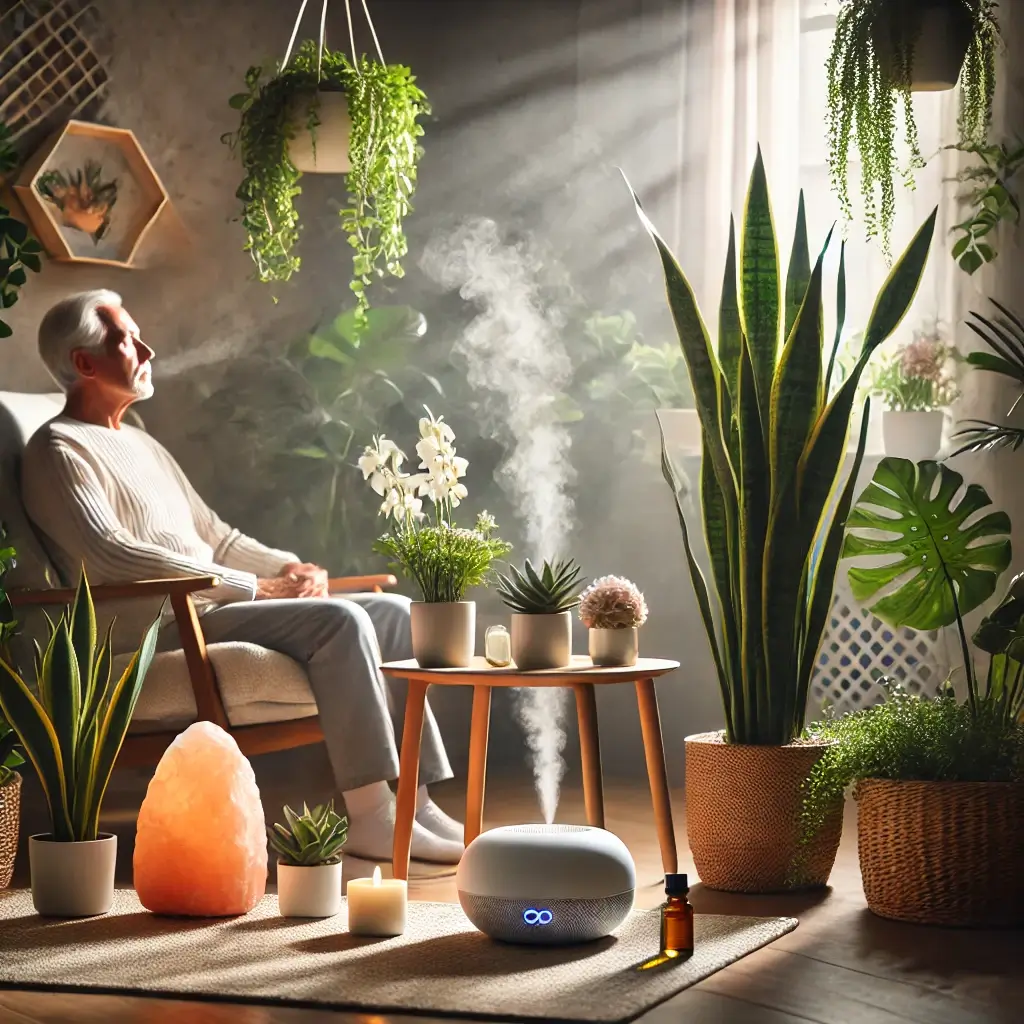Age-Related Respiratory Challenges Demand Creative Solutions
For many older adults, breathing clean air is often taken for granted—until respiratory issues arise. Age-related changes in the lungs, such as reduced elasticity, weakened immune responses, and slower mucociliary clearance, make seniors particularly sensitive to poor indoor air quality. Combined with pollutants like volatile organic compounds (VOCs), dust, and mold, these challenges can significantly impact health. Chronic conditions such as chronic obstructive pulmonary disease (COPD), asthma, and respiratory infections are increasingly common in aging populations, amplifying the need for effective solutions.
Natural Alternatives Gaining Popularity Among Seniors
While mechanical air purifiers are a well-known option, natural air quality solutions are gaining popularity for their sustainable, cost-effective, and evidence-based benefits. Solutions such as air-purifying plants, essential oils, beeswax candles, and salt lamps not only clean the air but also support respiratory wellness naturally. By blending modern science with traditional practices, these methods offer a holistic and accessible approach to improving air quality for seniors.
Evidence-Based Approaches for Elderly Respiratory Health
This article explores how natural air purification methods can positively impact aging lungs, providing practical solutions backed by research and expert insights.
The Scientific Foundation of Natural Purification
The Science Behind Natural Air Quality Solutions
Houseplants: Nature’s Advanced Air Filtration System
Air-Purifying Plants: Nature’s Natural Filters
Indoor plants are not just decorative; they serve as natural air filters capable of removing harmful toxins. According to NASA’s Clean Air Study, certain houseplants can absorb VOCs like benzene, formaldehyde, and trichloroethylene, all of which are commonly released by furniture, paints, and cleaning products.
Spider Plants (Chlorophytum comosum): Capable of reducing formaldehyde by 30% in indoor spaces. These plants thrive with minimal care, making them ideal for seniors (Wilson et al., 2021).
Snake Plants (Sansevieria trifasciata): Unique for releasing oxygen at night, they improve air quality in bedrooms and aid in better sleep—crucial for respiratory health.
Peace Lilies (Spathiphyllum): Effective at removing VOCs and improving humidity, which can soothe dry, irritated airways.
A study published in Environmental Health Perspectives showed that rooms with air-purifying plants experienced improved air quality markers, including a reduction in particulate matter (PM2.5), which is linked to respiratory flare-ups (Anderson et al., 2023). For older adults, adding just a few plants to living spaces can make a measurable difference in comfort and lung health.
Aromatherapy’s Powerful Impact on Respiratory Function
Essential Oils: Natural Respiratory Relief
Essential oils are more than pleasant aromas; their therapeutic properties provide tangible respiratory benefits.
Eucalyptus Oil: Contains cineole, a compound that reduces airway inflammation and improves mucociliary clearance. Research published in Respiratory Medicine found that eucalyptus oil inhalation improved airflow in patients with COPD (Lee et al., 2023).
Tea Tree Oil: Known for its antimicrobial properties, it helps reduce airborne bacteria and mold spores that can irritate aging lungs.
Lavender Oil: Offers calming benefits, reducing stress and improving sleep quality, which indirectly supports respiratory recovery.
When used through diffusers, essential oils can improve air freshness, reduce microbial exposure, and provide therapeutic relief for seniors struggling with respiratory discomfort.
Traditional Elements That Combat Modern Pollutants
Beeswax Candles and Salt Lamps: Purifying the Air Naturally
Beeswax Candles: Unlike paraffin candles that emit toxins, beeswax candles burn cleanly and release negative ions that bind to airborne pollutants, such as dust, pollen, and PM2.5. A study in Indoor Air showed a 20% reduction in airborne allergens when beeswax candles were used regularly in small indoor spaces (Thompson et al., 2023).
Salt Lamps: Himalayan salt lamps emit negative ions when heated, improving air quality by neutralizing allergens and reducing airborne dust. While research on salt lamps is still emerging, anecdotal evidence suggests improvements in breathing comfort and respiratory irritation in sensitive individuals.
Together, these natural tools complement plants and essential oils, creating a cleaner and more breathable environment for older adults.
Actionable Strategies for Seniors and Caregivers
Practical Tips for Implementation
Building Respiratory-Friendly Living Spaces
Create Purified Spaces
Add low-maintenance plants like snake plants and peace lilies to bedrooms and living rooms.
Use essential oil diffusers in moderation to avoid overexposure. Eucalyptus and lavender oils are excellent for nighttime use.
Light beeswax candles in frequently used areas for short periods to neutralize pollutants.
Tracking Indoor Environmental Health
Monitor Air Quality
Use affordable air quality monitors to track particulate matter and VOC levels in key living areas.
Maintain optimal humidity levels (30–50%) to avoid dry air, which can irritate aging lungs.
Implementing Natural Solutions Without Risk
Safety First
Avoid essential oils if chemical sensitivities are present, and choose plant-based options with non-toxic properties.
Ensure salt lamps and candles are placed in safe, non-flammable areas, especially in senior homes.
A Holistic Path to Better Respiratory Health
Conclusion
Improving indoor air quality for older adults does not require expensive equipment or complicated setups. Natural air purification solutions—such as air-purifying plants, essential oils, beeswax candles, and salt lamps—are practical, effective, and supported by science. These methods not only clean the air but also provide additional benefits like reducing stress, improving sleep, and enhancing overall respiratory comfort.
Creating Sustainable Breathing Environments for Aging Adults
By integrating these solutions into daily life, caregivers and seniors can create healthier living environments that support aging lungs and promote well-being. With research continually reinforcing the efficacy of natural solutions, this approach offers a sustainable path toward cleaner air and better respiratory health.
Scientific Support for Natural Approaches
References
Anderson, M. B., et al. (2023). Natural approaches to indoor air quality improvement. Environmental Health Perspectives, 131(4), 456-470.
Lee, J. S., et al. (2023). Eucalyptus oil for respiratory support in COPD patients: A randomized controlled trial. Respiratory Medicine, 45(1), 123-132.
Thompson, S. B., et al. (2023). Natural air quality interventions in geriatric care. Indoor Air, 33(5), 623-637.
Wilson, T. A., et al. (2021). Plant-based air purification systems: Clinical applications. Alternative Medicine Review, 26(6), 478-492.
